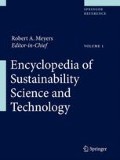Access this chapter
Tax calculation will be finalised at checkout
Purchases are for personal use only
Abbreviations
- CBA:
-
Cost benefit analysis – A decision-making tool that compares costs and benefits of a proposed policy or project in monetary terms. The aim is to find the most beneficial (highest net benefit) option of achieving a given objective. Taking no action is also included as an option.
- CEA:
-
Cost effectiveness analysis – A decision-making tool that compares the costs of a proposed policy or project to a (nonmonetary) measure of its benefits. The aim is to find the option that generates the highest benefit for each unit of money spent.
- TEV:
-
Total economic value – The economic value of a resource comprised of its use and nonuse values.
Bibliography
Primary Literature
Hardisty PE, Bracken RA, Knight M (1998) The economics of contaminated site remediation: decision making and technology selection. Geol Soc Eng Geol Sp Pub 14:63–71
Hardisty PE, Wheater HS, Johnston PM, Bracken RA (1998) Behaviour of light immiscible liquid contaminants in fractured aquifers. Geotechnique 48(6):747–760
Goist TO, Richardson TC (2003) Optimizing cost reductions while achieving long term remediation effectiveness at active and closed wood preserving facilities. In: Proceedings, NGWA conference on remediation: site closure and the total cost of cleanup, New Orleans, Nov 2003
Perakami MP, Donovan PB (2003) A remedial-goal driven, media-specific method for conducting a cost benefit analysis of multiple remedial approaches. In: Proceedings, NGWA conference on remediation: site closure and the total cost of cleanup, New Orleans
Hardisty PE, Kramer E, Ozdemiroglu E, Brown A (1999) Economic analysis of remedial objective alternatives for an MtBE contaminated aquifer. In: Proceedings of hydrocarbons and organic chemicals in groundwater conference, NGWA, Houston
Pearce DW, Warford JJ (1993) World without end. Edward Elgar, London
Hardisty PE, Ozdemiroglu E (2005) The economics of groundwater remediation and protection. CRC Press, New York
Hardisty PE (2010) Environmental and economic sustainability. CRC Press, New York
Hardisty PE, Arch S, Ozdemiroglu E (2008) Sustainable remediation: including the external costs of remediation. Land Contam Reclam 16:4
Maddison D, Pearce DW, Johansson O, Calthorp E, Litman T, Verhoef E (1996) The true costs of road transport. Earthscan, London
Hardisty PE, Ozdemiroglu E (1999) Costs and benefits associated with remediation of contaminated groundwater: a review of the issues. UK Environment Agency Technical Report P278
DEFRA (2003) A study to estimate the disamenity costs of landfill in Great Britain. Final report by Cambridge Econometrics with EFTEC and WRc
Gawande K, Jenkins-Smith H (2001) Nuclear waste transport and residential property values: estimating effects of perceived risks. J Environ Econ Manage 42:207–233
Payne B, Olshansky S, Segel T (1987) The effects on property values of proximity to a site contaminated with radioactive waste. Nat Resour J 27:579–590
Hirshfeld S, Veslind PA, Pas EI (1992) Assessing the true cost of landfills. Water Manage Res 10:471–484
Mackay DM, Cherry JA (1989) Groundwater contamination: pump-and-treat remediation. Environ Sci Technol 23:6
Cohen RM, Mercer JW (1993) In: Smoley CK (ed) DNAPL site investigation. CRC Press, Boca Raton
CL:AIRE (2002) Introduction to an integrated approach to the investigation of fractured rock aquifers contaminated with non-aqueous phase liquids. Technical Bulletin TB1
Guswa JH, Benjamin AE, Bridge JR, Schewing LE, Tallon CD, Wills JH, Yates CC, LaPoint EK (2001) Use of FLUTe systems for characterisation of groundwater contamination in fractured bedrock. In: Kueper BH, Novakowski KS, Reynolds DA (eds) Conference proceedings of fractured rock 2001, Toronto
Lane JW Jr, Buursink ML, Haeni FP, Versteeg RJ (2000) Evaluation of ground penetrating radar to detect free-phase hydrocarbon in fractured rocks – results of numerical modelling and physical experiments. Ground Water 38:6
Schmelling SG, Ross RR (1989) Contaminant transport in fractured media: models for decision makers. EPA Superfund Issue Paper EPA/540/4-89/004
Taylor TP, Pennell KD, Abriola LM, Dane JH (2001) Surfactant enhanced recovery of tetrachloroethylene from a porous medium containing low permeability lenses: 1. experimental studies. J Contam Hydrol 48:325–350
DEFRA (2007) The social cost of carbon and the shadow price. What they are and how to use them in economic appraisal in the UK. UK Department of Environment, Food and Rural Affairs, London
Books and Reviews
Boardman AE, Greenberg DH, Vining AR, Weimer DL (2010) Cost-benefit analysis: concepts and practice. Pearson, Prentice Hall, Upper Saddle River
Brouwer R, Pearce D (eds) (2005) Cost-benefit analysis and water resources management. Edward Elgar, Cheltenham
Pearce DW, Atkinson G, Mourato S (2006) Cost benefit analysis and the environment – recent developments. OECD, Paris
Tientenberg T (2003) Environmental and natural resource economics. Addison Wesley, London
Author information
Authors and Affiliations
Corresponding author
Editor information
Editors and Affiliations
Additional information
The interested reader is referred to Environmental and Economic Sustainability (Hardisty 2010; CRC Press, New York) for a detailed presentation of the EESA method, and a wide variety of case histories on remediation and options selection in water management, energy options, greenhouse gas management, and waste issues. This article has borrowed extensively from this book.
For a general introduction to Cost Benefit Analysis in particular and environmental economics in general, there are several text books. A few are listed in the “Books and Reviews” section.
Rights and permissions
Copyright information
© 2012 Springer Science+Business Media, LLC
About this entry
Cite this entry
Hardisty, P., Ozdemiroglu, E. (2012). Groundwater Remediation , Environmental and Economic Assessment. In: Meyers, R.A. (eds) Encyclopedia of Sustainability Science and Technology. Springer, New York, NY. https://doi.org/10.1007/978-1-4419-0851-3_65
Download citation
DOI: https://doi.org/10.1007/978-1-4419-0851-3_65
Publisher Name: Springer, New York, NY
Print ISBN: 978-0-387-89469-0
Online ISBN: 978-1-4419-0851-3
eBook Packages: Earth and Environmental ScienceReference Module Physical and Materials ScienceReference Module Earth and Environmental Sciences

